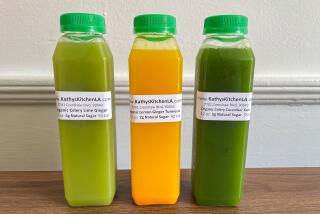Fruit-Drink Makers on Lookout for Next Exotic Flavor : Marketing: Kiwi-strawberry is still the buyers’ favorite, but it’s expected to eventually run out of juice.
- Share via
There may be a run on tamarinds, guarana berries and other exotic fruits as beverage makers rush to come up with a successor to kiwi-strawberry.
Kiwi-strawberry, introduced three years ago by Snapple Beverage Co., is the current magic mix. Competitors jumped in with dozens of other kiwi-strawberry drinks, from real fruit juice to artificially flavored herbal teas.
Sales of kiwi-strawberry drinks are only a small portion of the $12-billion-a-year market for ready-to-drink juices, according to Jesse Myers’ Beverage Digest.
Yet they sparked a trend that put guava and ginseng drinks on supermarket shelves and helped the juice-drink market grow 11% in 1994. Beverage makers, who don’t believe fickle American consumers will be satisfied with kiwis and mangoes forever, are looking beyond Caribbean flavors for new lines.
“Probably by next summer we’ll start to see a whole new variety of . . . more exotic flavors,” including tamarind and guarana, said Kathleen Lichtendahl, director of marketing for Horizon Tea & Spice Co.’s Tradewinds Beverages.
Coca-Cola Co. and PepsiCo Inc. have latched onto guarana, a caffeinated Amazonian berry that accounts for 22% of Brazil’s annual $3-billion in carbonated drink sales. A bright red berry with little flavor, it has long been used in teas and tablets. Some Amazon Indians consider it an aphrodisiac.
The giants of the soft drink industry, which had sales of $51 billion last year from 13.3 billion gallons of soda, are each developing a guarana beverage.
Purchase, N.Y.-based Pepsi recently tested Josta, a guarana drink, in American markets. Atlanta-based Coke, which already sells a guarana beverage called Tai in Brazil, won’t say whether it will offer the drink in the United States.
Cola flavors still account for 63.9% of the ready-to-drink beverage market. Lemon-lime, the only significant fruit flavor, has a 12% share, according to Jesse Myers’ Beverage Digest.
Companies in the highly competitive ready-to-drink beverage industry won’t talk about tamarinds or anything else they may be mixing up.
Tamarind, the datelike fruit of the tamarind tree, is a brown pod enclosing one to 12 seeds. It has a reddish, tangy pulp that has been used to make medicines and relishes.
What other new products can the beverage industry expect? More iced teas, more herbal drinks and more innovative flavors. As competition continues to intensify, the race is on to produce distinctive drinks.
“You’re going to have the tropicals out there, but you’re going to have the herbals popping up, even paired with tropicals,” said Patricia Horning, a marketing specialist for Tastemaker, the Cincinnati-based flavor house. One possibility: familiar orange with more exotic ginger.
“The more interesting the blends, the better,” Horning said. “Anything that shows variety is what the consumer is going to drink.”
New drinks on the market include Ralph’s Cantaloupe Cocktail, marketed by Snapple, and Kickin’ Kiwi-Lime Kool-Aid, marketed by Kraft General Foods Inc. of Northfield, Ill., a unit of Philip Morris Inc. Kraft also sells a Crystal Light Tropical Passions line, which includes not only a kiwi-strawberry flavor but passion fruit-pineapple.
Snapple, the Quaker Oats unit that started it all, doesn’t talk about its sales or the flavors in its future.
Right now, “our No. 1 flavor is kiwi-strawberry,” said Margaret Stender, marketing vice president. Mango Madness Cocktail is No. 2, with more traditional pink lemonade and fruit punch in third and fourth places.
Popular as the tropicals are, at least one analyst said American consumers may be ready for a change from kiwi-strawberry and other tropical flavors the industry has labeled “new-age.”
Jennifer Solomon, a securities analyst for Josepthal Lyon & Ross, thinks traditional tastes like coffee and chocolate will be marketed in new ways.
“We’ve seen a lot of chocolate drinks,” Solomon said. “Everybody is trying to capitalize on the success of Yoo-Hoo,” a creamy chocolate drink sold in cans by New York-based Austin-Nichols & Co.
As for the juice-drink industry, “there’s still a lot going on there, and will continue to be,” Solomon said. While Snapple started the rush toward tropical flavors, “everybody’s doing interesting flavors: Coke with Fruitopia, AriZona with ginseng iced tea.” AriZona is a product of Brooklyn, N.Y.-based Ferolito, Vultaggio & Sons, a privately held company.
She said Snapple President and CEO Leonard Marsh has been the company’s secret weapon. “What it really came down to was Marsh’s taste buds,” she said. “That’s really why they’re the flavor innovator.”
More to Read
Eat your way across L.A.
Get our weekly Tasting Notes newsletter for reviews, news and more.
You may occasionally receive promotional content from the Los Angeles Times.










